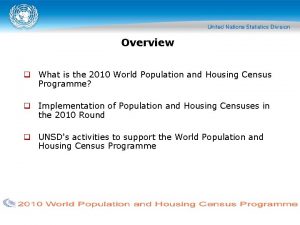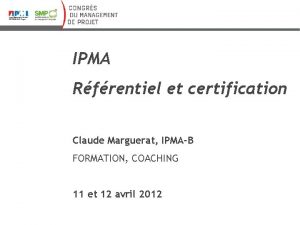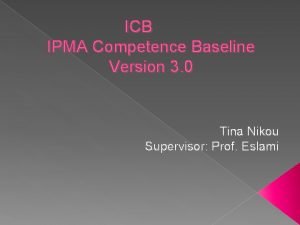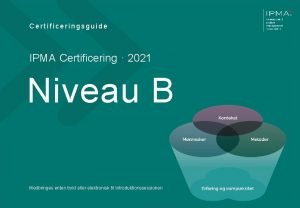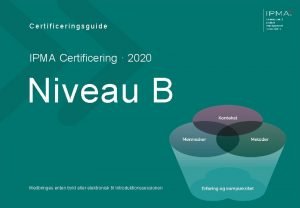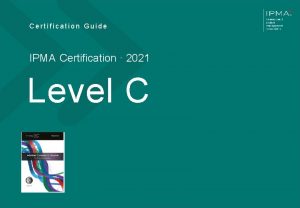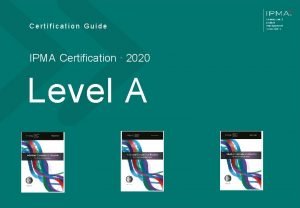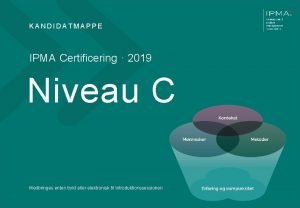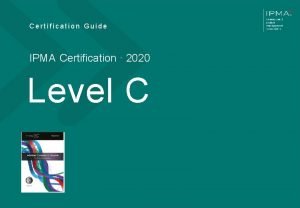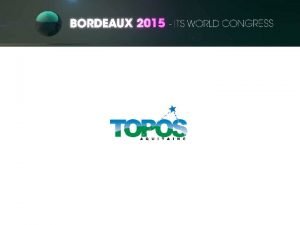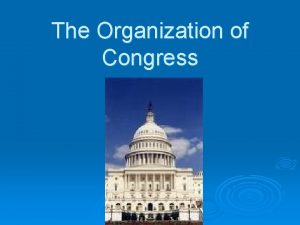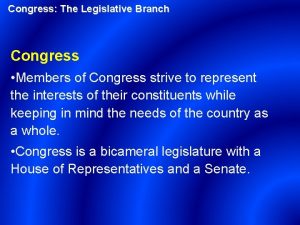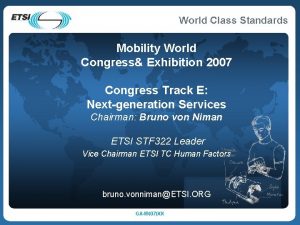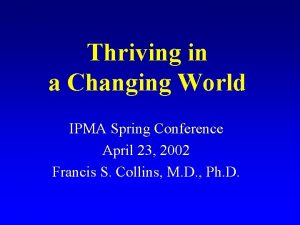24 th IPMA World Congress www ipma 2010















- Slides: 15

24 th IPMA World Congress www. ipma 2010. com Uncertainty management in the directorate of public construction and property, Norway (Statsbygg) – From an immature to a mature actor Anandasivakumar Ekambaram Research Scientist, SINTEF – Technology and Society, Agnar Johansen Senior Scientist, SINTEF – Technology and Society, Ragnhild Aalstad Project Manager, Statsbygg, Asbjørn Hansen Project Manager, OPAK, 1 -3 November 2010, Istanbul, Turkey

Context • PUS-project: Practical Uncertainty Management in a Project Owner perspective (PUS). www. nsp. ntnu. no/pus • The project is financed by the Norwegian Research Council and by six large norwegian industrial partners • Focus: PUS aims to develop a new way of thinking, managing and governing uncertainty in projects • Statsbygg (The Directorate of Public Construction and Property):

Context of the study • Organisational context – Statsbygg: The largest Norwegian public sector organisation – The SUS-project: Management of uncertainty in Statsbygg • Research methods – Qualitative research

The five levels of maturity-Uncertainty management s es n c Pro finitio De e sic ledg a B ow Level 2: Kn Common Processes Level 1: Common Language s es c o Pr ntrol Co ss ent e c m Pro prove Im Level 5: Continuous Improvement Level 4: Benchmarking Level 3: Singular Methodology Kerzner, Harold (2009): Project Management – A systems approach to planning, scheduling and controlling, John Wiley & Sons, Inc.

Master –Uncertaintymanagement in Statsbygg- Experience and new models (Lund 2006 -2007) 2007 1 No 0 -25% 2 Work has been started 26 -50% Level 1 Naive organization Level 2 Novice organization 3 Yes 4 Yes, in a good way 51 -75% 76 -100% Level 3 Normal organization Level 4 Mature organization Maturity model Risk management based on CMM (Capability Maturity Model) and EFQM (European Foundation for Quality Management) (Lund, 2007).

Project timeline SUS project- overwiev Taskes 2006 2007 2008 2009 2010 Project start-up As – is studie in Statsbygg Focus seminars Case studies 8 - case projects Developing models and tools E- modul (course) uncertain management Follow up system UM 3 days course- More then 100 participants

Work process for uncertainty management - Statsbygg

The Case projects Case project Period R 6 - Construction of the new Governmental block 2007 -2010 IFI 2 2007 -2009 University college in Vestfold 2007 -2009 Halden Prison 2007 -2009 Lapp scientific centre 2007 -2009 Norwegian central bank 2008 -2009 Domus media 2009 -2010 National theatre 2010 -

Case – short presentation Case project R 6 What was tested The role of uncertainty coordinator was developed and tested out. The first version of the monthly report was developed, and it included the issue of uncertainty. Uncertainty matrix – a tool for managing uncertainty was developed and tested out. A testing was made in order to know how frequent large scale of uncertainty analysis should be carried out in the planning and the execution phase. A plan for uncertainty management was developed and tested out. A testing was conducted in order to understand what kinds of uncertainty analysis were relevant in the planning and the execution phase – Time analysis and cost analysis were applied here. A researcher from the PUS-project directly involved in the development process as an action researcher IFI 2 A routine for reporting uncertainty in the execution phase was tested out. This case was used as a testing arena where the results of the test were obtained through interviews by researchers from the PUS-project. University A routine for reporting uncertainty in the execution phase was tested out. This case was college in used as a testing arena where the results of the test were obtained through interviews by Vestfold researchers from the PUS-project. Halden A routine for reporting uncertainty in the execution phase was tested out. This case was Prison used as a testing arena where the results of the test were obtained through interviews by researchers from the PUS-project.

Case – short presentation Case project Lapp scientific centre What was tested Establishing uncertainty register (a tool for registering uncertainty) in the execution phase was tested out. A new routine for reporting uncertainty was tested out. A researcher from the PUS-project directly involved in the development process as an action researcher. Norwegian Establishing uncertainty register (a tool for registering uncertainty) in the central bank execution phase was tested out. A new routine for reporting uncertainty was tested out. A researcher from the PUS-project directly involved in the development process as an action researcher. Domus media Establishing uncertainty register (a tool for registering uncertainty) in the planning phase was tested out. A routine for reporting uncertainty was tested out. A methodology for auditing the uncertainty register every other month was tested out. The role of uncertainty coordinator was tested out. A researcher from the PUS-project directly involved in the development process as an action researcher. National Establishing uncertainty register (a tool for registering uncertainty) in theatre planning phase was tested out. A routine for reporting uncertainty was tested out. A methodology for auditing the uncertainty-register every other month was tested out. The role of uncertainty coordinator was tested out. A researcher from the PUS-project directly involved in the development process as an action researcher.

Existing initiatives to transfer knowledge in the organisation • The organisation – – – “The House” Statsbygg School New routines and tools Meetings and seminars Research activities • The projects – – Following up contracts Routines for reporting and meetings Uncertainty analyses Instances of knowledge transfer in individual projects

From an immature to a mature actor 2007 1 No 0 -25% 2 Work has been started 26 -50% Level 1 Naive organization Level 2 Novice organization 2010 3 Yes 4 Yes, in a good way 51 -75% 76 -100% Level 3 Normal organization Level 4 Mature organization

Concluding remarks • By the help of the SUS-project, Statsbygg has gone from being an immature organization to a mature organization when it comes to managing uncertainty in complex construction projects. • Statsbygg has now got a common way of handling and managing uncertainty, and the common way is presented in the form of routines and procedures. • Statsbygg has got common tools as well as guidelines for applying the tools. • A new role called uncertainty coordinator has been established.

Concluding remarks • A course-concept has been developed with the intention of providing practical knowledge in uncertainty management. In the mean time, a range of focus-seminars have been conducted. • Focous seminar for top mangement level – The seminars have contributed to ensuring that the methodology is placed firmly at the top management level down to department directors and further down to individual projects. • In addition, an organizational unit has been put in place – an organizational unit that develops further the methodology and follows up the utilization of the new system (of managing uncertainty) within the limited duration of the SUS-project.

Thank you • Contact information: – – A. Ekambaram: siva@sintef. no A. Johansen: Agnar. Johansen@sintef. no Ragnhild Aalstad – Statsbygg Asbjørn Hansen - OPAK • Norwegian Center of Project Management (NSP): http: //www. nsp. ntnu. no • Questions
 Landscape hotels world congress
Landscape hotels world congress Automotive news world congress
Automotive news world congress Automotive news world congress
Automotive news world congress 2010 world population
2010 world population Ipma weiterbildung
Ipma weiterbildung Ipmab
Ipmab Ipma competence baseline
Ipma competence baseline Ipma self assessment
Ipma self assessment Ipma b certificering
Ipma b certificering Ipma certificering pris
Ipma certificering pris Ipma c certification
Ipma c certification Ipma self assessment
Ipma self assessment Zoom meeting teilnehmerliste exportieren
Zoom meeting teilnehmerliste exportieren Ipma c
Ipma c Prince2 recertificering
Prince2 recertificering Document answers
Document answers



